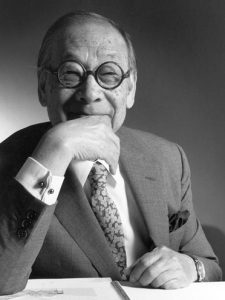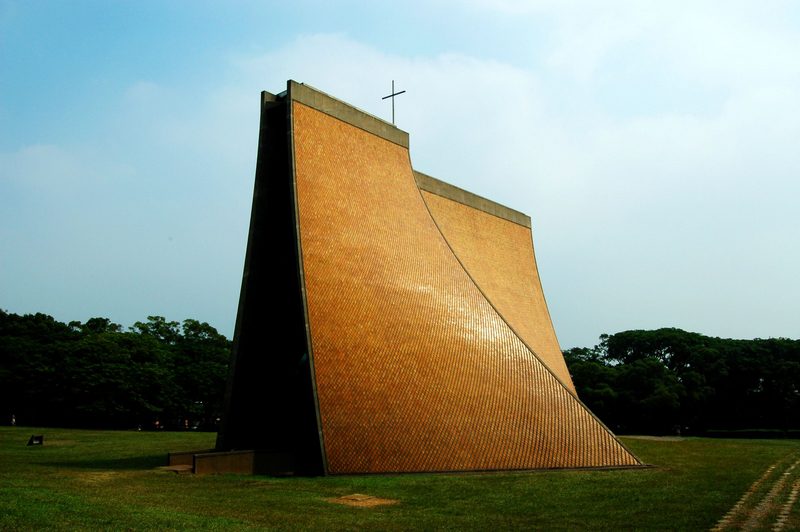ARCHITECTURE: I.M.Pei
 I.M. Pei (2/4/1917-16/5/2019), is a Chinese-born American architect often called the master of modern architecture. In 1948, Pei was recruited by New York real estate magnate William Zeckendorf for seven years. Pei has won a wide variety of prizes and awards in the field of architecture, including the AIA Gold Medal in 1979, the first Praemium Imperiale for Architecture in 1989, and the Lifetime Achievement Award from the Cooper-Hewitt, National Design Museum in 2003. In 1983, he won the Pritzker Prize, sometimes called the Nobel Prize of architecture.
I.M. Pei (2/4/1917-16/5/2019), is a Chinese-born American architect often called the master of modern architecture. In 1948, Pei was recruited by New York real estate magnate William Zeckendorf for seven years. Pei has won a wide variety of prizes and awards in the field of architecture, including the AIA Gold Medal in 1979, the first Praemium Imperiale for Architecture in 1989, and the Lifetime Achievement Award from the Cooper-Hewitt, National Design Museum in 2003. In 1983, he won the Pritzker Prize, sometimes called the Nobel Prize of architecture.
By Efi Michalarou
 While studying in Shanghai, he had closely examined the catalogs for various institutions of higher learning around the world. The architectural program at the University of Pennsylvania stood out to him. The other major factor was Hollywood. “College life in the U.S. seemed to me to be mostly fun and games”, he said in 2000. “Since I was too young to be serious, I wanted to be part of it … You could get a feeling for it in Bing Crosby’s movies. College life in America seemed very exciting to me. It’s not real, we know that. Nevertheless, at that time it was very attractive to me. I decided that was the country for me”. In 1935 Pei boarded the SS President Coolidge and sailed to San Francisco, then traveled by train to Philadelphia. What he found, however, differed vastly from his expectations. Professors at the University of Pennsylvania based their teaching in the Beaux-Arts style, rooted in the classical traditions of Greece and Rome. Pei was more intrigued by modern architecture, and also felt intimidated by the high level of drafting proficiency shown by other students. He decided to abandon architecture and transferred to the engineering program at Massachusetts Institute of Technology (MIT). Once he arrived, however, the dean of the architecture school commented on his eye for design and convinced Pei to return to his original major. MIT’s architecture faculty was also focused on the Beaux-Arts school, and Pei found himself uninspired by the work. In the library he found three books by the Swiss-French architect Charles-Édouard Jeanneret-Gris, better known as Le Corbusier. Le Corbusier visited MIT in November 1935, an occasion which powerfully affected Pei: “The two days with Le Corbusier, or ‘Corbu’ as we used to call him, were probably the most important days in my architectural education”. Pei received his Bachelors of Architecture degree in 1940. He planned to return to China immediately afterward, but the Second Sino-Japanese War forced him to change his plans. Pei’s father urged him to remain in the United States, and he worked for two years at the Boston engineering firm of Stone & Webster.While visiting New York City in the late ’30s, Pei met a Wellesley College student named Eileen Loo. They began dating and they married in the spring of 1942. She enrolled in the landscape architecture program at Harvard University, and Pei was thus introduced to members of the faculty at Harvard’s Graduate School of Design (GSD). He was excited by the lively atmosphere, and joined the GSD in December 1942. Less than a month later, Pei suspended his work at Harvard to join the National Defense Research Committee, which coordinated scientific research into US weapons technology during World War II. Pei’s background in architecture was seen as a considerable asset one member of the committee told him: “If you know how to build you should also know how to destroy”. The fight against Germany was ending, so he focused on the Pacific War. The US realized that its bombs used against the stone buildings of Europe would be ineffective against Japanese cities, mostly constructed from wood and paper Pei was assigned to work on incendiary bombs. Pei spent two and a half years with the NDRC, but has revealed few details. Pei returned to Harvard in the autumn of 1945, and received a position as assistant professor of design. In 1948 started working for the William Zeckendorf, Real Estate, he spent seven years before establishing his own independent design firm I. M. Pei & Associates in 1955, which became I.M. Pei & Partners in 1966 and later in 1989 became Pei Cobb Freed & Partners. Pei retired from full-time practice in 1990. Since then, he has taken on work as an architectural consultant primarily from his sons’ architectural firm Pei Partnership Architects. Among the early projects on which Pei took the lead were the L’Enfant Plaza Hotel in Washington, D.C. and the Green Building at MIT. His first major recognition came with the National Center for Atmospheric Research in Colorado, his new stature led to his selection as chief architect for the John F. Kennedy Library in Massachusetts. He went on to design Dallas City Hall and the East Building of the National Gallery of Art. When François Mitterrand was elected President of France in 1981, he laid out an ambitious plan for a variety of construction projects. One of these was the renovation of the Louvre Museum. He thus became the first foreign architect to work on the Louvre, so he designed the Pyramids of Louvre. During the first decade of the 2000s, Pei designed a variety of buildings, including the Suzhou Museum near his childhood home. He also designed the Museum of Islamic Art in Doha, Qatar at the request of the Al-Thani Family.
While studying in Shanghai, he had closely examined the catalogs for various institutions of higher learning around the world. The architectural program at the University of Pennsylvania stood out to him. The other major factor was Hollywood. “College life in the U.S. seemed to me to be mostly fun and games”, he said in 2000. “Since I was too young to be serious, I wanted to be part of it … You could get a feeling for it in Bing Crosby’s movies. College life in America seemed very exciting to me. It’s not real, we know that. Nevertheless, at that time it was very attractive to me. I decided that was the country for me”. In 1935 Pei boarded the SS President Coolidge and sailed to San Francisco, then traveled by train to Philadelphia. What he found, however, differed vastly from his expectations. Professors at the University of Pennsylvania based their teaching in the Beaux-Arts style, rooted in the classical traditions of Greece and Rome. Pei was more intrigued by modern architecture, and also felt intimidated by the high level of drafting proficiency shown by other students. He decided to abandon architecture and transferred to the engineering program at Massachusetts Institute of Technology (MIT). Once he arrived, however, the dean of the architecture school commented on his eye for design and convinced Pei to return to his original major. MIT’s architecture faculty was also focused on the Beaux-Arts school, and Pei found himself uninspired by the work. In the library he found three books by the Swiss-French architect Charles-Édouard Jeanneret-Gris, better known as Le Corbusier. Le Corbusier visited MIT in November 1935, an occasion which powerfully affected Pei: “The two days with Le Corbusier, or ‘Corbu’ as we used to call him, were probably the most important days in my architectural education”. Pei received his Bachelors of Architecture degree in 1940. He planned to return to China immediately afterward, but the Second Sino-Japanese War forced him to change his plans. Pei’s father urged him to remain in the United States, and he worked for two years at the Boston engineering firm of Stone & Webster.While visiting New York City in the late ’30s, Pei met a Wellesley College student named Eileen Loo. They began dating and they married in the spring of 1942. She enrolled in the landscape architecture program at Harvard University, and Pei was thus introduced to members of the faculty at Harvard’s Graduate School of Design (GSD). He was excited by the lively atmosphere, and joined the GSD in December 1942. Less than a month later, Pei suspended his work at Harvard to join the National Defense Research Committee, which coordinated scientific research into US weapons technology during World War II. Pei’s background in architecture was seen as a considerable asset one member of the committee told him: “If you know how to build you should also know how to destroy”. The fight against Germany was ending, so he focused on the Pacific War. The US realized that its bombs used against the stone buildings of Europe would be ineffective against Japanese cities, mostly constructed from wood and paper Pei was assigned to work on incendiary bombs. Pei spent two and a half years with the NDRC, but has revealed few details. Pei returned to Harvard in the autumn of 1945, and received a position as assistant professor of design. In 1948 started working for the William Zeckendorf, Real Estate, he spent seven years before establishing his own independent design firm I. M. Pei & Associates in 1955, which became I.M. Pei & Partners in 1966 and later in 1989 became Pei Cobb Freed & Partners. Pei retired from full-time practice in 1990. Since then, he has taken on work as an architectural consultant primarily from his sons’ architectural firm Pei Partnership Architects. Among the early projects on which Pei took the lead were the L’Enfant Plaza Hotel in Washington, D.C. and the Green Building at MIT. His first major recognition came with the National Center for Atmospheric Research in Colorado, his new stature led to his selection as chief architect for the John F. Kennedy Library in Massachusetts. He went on to design Dallas City Hall and the East Building of the National Gallery of Art. When François Mitterrand was elected President of France in 1981, he laid out an ambitious plan for a variety of construction projects. One of these was the renovation of the Louvre Museum. He thus became the first foreign architect to work on the Louvre, so he designed the Pyramids of Louvre. During the first decade of the 2000s, Pei designed a variety of buildings, including the Suzhou Museum near his childhood home. He also designed the Museum of Islamic Art in Doha, Qatar at the request of the Al-Thani Family.









